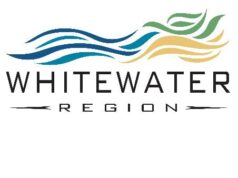ONTARIO —United Shoreline Ontario organized a march onto Parliament Hill on Saturday, November 23 in Ottawa. The protest went from the office of the International Joint Commission and gathered on Parliament Hill. Cheryl Gallant, MP gave an Ottawa Valley view of Plan 2014 at the “Rally To Repeal Plan 2014” in Trenton. She talked about the experiences of local residents in the Ottawa Valley, who have faced catastrophic flooding in two of the last three years. The event was organized by USO, a volunteer group of flood victims, who have banded together to fight bad federal government flood policy.
When high water is released from Lake Ontario in the spring, water is held back in the Ottawa River to prevent excessive flooding downstream in Montreal, which results in flooding the valley. Conversely, when the water is released from the Ottawa River, flooding occurs on the shores of Lake Ontario as water is held back on the St. Lawrence River behind the dam at Cornwall.
Joining MP Cheryl Gallant were MP Philip Lawrence, Northumberland-Peterborough South, Derek Sloan, MP Hastings-Lennox and Addington, Mayor Jim Harrison, Quinte West, Mayor Mitch Panciuk, Belleville, Mayor Steve Ferguson, Prince Edward County, Mayor Brian Ostrander, Brighton, Reeve Rick Phillips, Tyendinaga, Deputy Mayor Max Kaiser, Greater Napanee.
The meeting was packed with flood victims from Toronto to communities all along the St. Lawrence River. Residents heard from a number of informed speakers. Included in the line-up was engineer Dr. Frank Sciremammano, who was removed from the International Lake Ontario-St. Lawrence River Board after serving 24 years for speaking out against Plan 2014.
Plan 2014 is a scheme that has raised water levels in the Great Lakes basin, which affects the Ottawa River watershed. It was approved in December 2016 by the Trudeau and the outgoing Obama administrations in the dying days of the Obama Presidency. Controversial from the outset, it was signed during the period between the date the new U.S. President was elected, November 8, 2016 and when he was sworn into office, January 20, 2017.
In the U.S., the legitimacy of signing the document during the “lame duck” period was called into question, particularly after flooding started in 2017. Calls for the repeal of Plan 2014 by U.S. flood victims began at that time. Plan 2014 is an agreement that changes a regulating system, which had been in place on the Great Lakes and the St. Lawrence River since 1958. One of its many goals is to create 64 thousand acres of wetland to fight climate change. Plan 2014 says it is designed to more closely mimic the lakes’ natural ups and downs, and adds muskrats, fish, and other wildlife to the list of interests regulators must now consider when they decide how much water to release.
The new regulation blocks the flow of water through the Moses-Saunders dam located on the St. Lawrence River between Cornwall, Ontario, and Massena, New York. By restricting the flow of the St. Lawrence, the entire Great Lakes –St. Lawrence watershed is now backing up.






![Kenopic/Smith Auction [Paid Ad]](https://whitewaternews.ca/wp-content/uploads/2018/10/advertising-100x75.jpeg)

